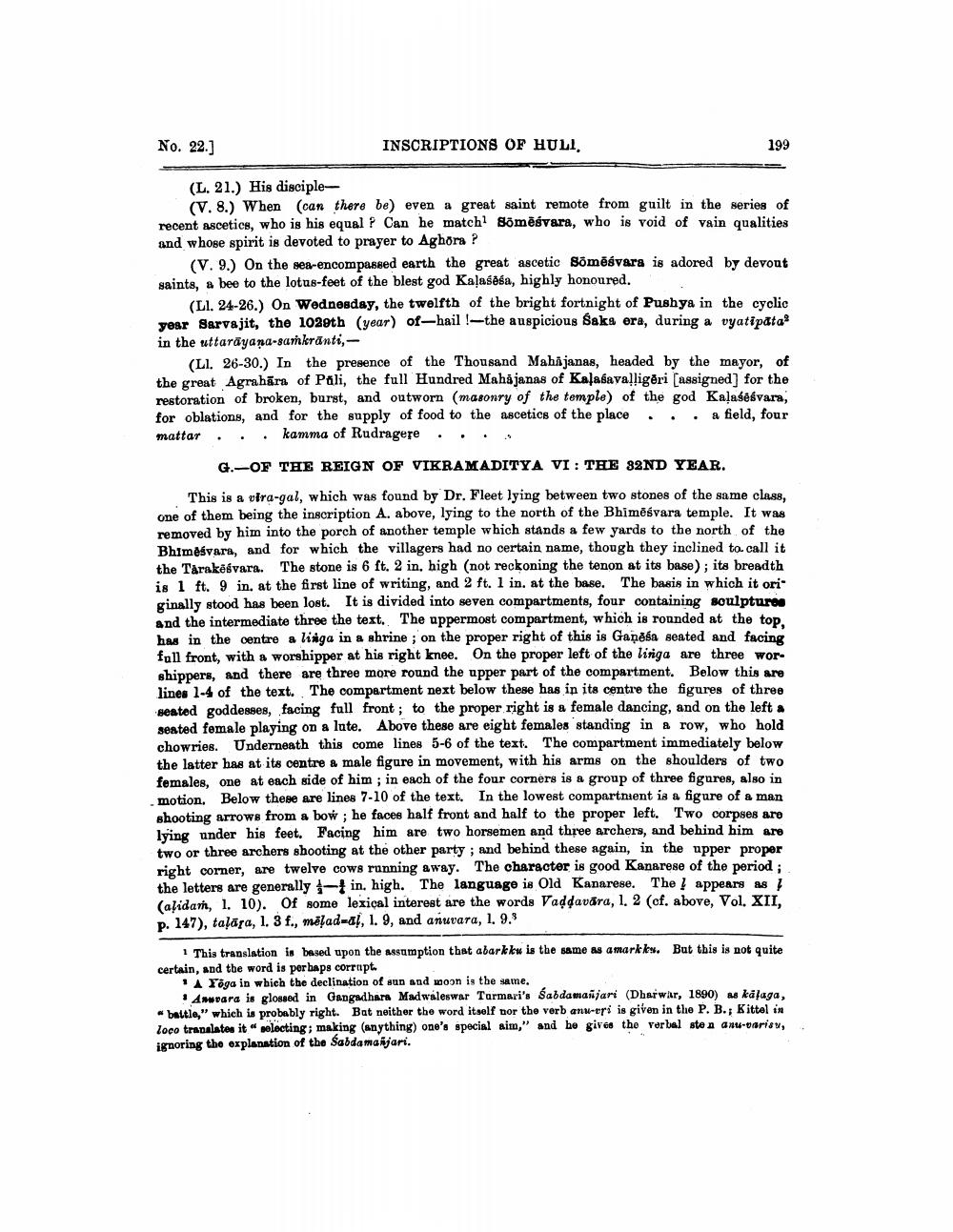________________
No. 22.]
INSCRIPTIONS OF HULI,
199
(L. 21.) His disciple
(V. 8.) When can there be) even a great saint remote from guilt in the series of recent ascetics, who is his equal ? Can he match? Sömēśvara, who is void of vain qualities and whose spirit is devoted to prayer to Aghora ?
(V. 9. On the sea-encompassed earth the great ascetic Somēsvara is adored by devout saints, a bee to the lotus-feet of the blest god Kalasėsa, highly honoured.
(Ll. 24-26.) On Wednesday, the twelfth of the bright fortnight of Pushya in the cyclic year Sarvajit, the 1029th (year) of-hail !--the auspicious Saks era, during a vyatipata in the uttarayana-sankranti,
(LI. 26-30.) In the presence of the Thousand Mahajanas, headed by the mayor, of the great Agrahāra of Páli, the full Hundred Mahajanas of Kalafavalligöri (assigned] for the restoration of broken, burst, and outworn (masonry of the temple) of the god Kalasesvara, for oblations, and for the supply of food to the ascetics of the place . . . a field, four mattar .. kamma of Rudragere . . . .
G.-OF THE REIGN OF VIKRAMADITYA VI: THE 82ND YEAR.
This is a vira-gal, which was found by Dr. Fleet lying between two stones of the same class, one of them being the inscription A. above, lying to the north of the Bhimosvara temple. It was removed by him into the porch of another temple which stands a few yards to the north of the Bhim svars, and for which the villagers had no certain name, though they inclined to call it the Tarakośvara. The stone is 6 ft. 2 in, high (not reckoning the tenon at its base); its breadth is 1 ft. 9 in, at the first line of writing, and 2 ft. 1 in. at the base. The basis in which it ori ginally stood has been lost. It is divided into seven compartments, four containing soulptures and the intermediate three the text. The uppermost compartment, which is rounded at the top. has in the centre a linga in a shrine ; on the proper right of this is Gandía seated and facing foll front, with a worshipper at his right knee. On the proper left of the liriga are three wor shippers, and there are three more round the upper part of the compartment. Below this are lines 1-4 of the text. The compartment next below these has in its centre the figures of three Heated goddesses, facing full front; to the proper right is a female dancing, and on the left a seated female playing on a lute. Above these are eight females standing in a row, who hold chowries. Underneath this come lines 5-6 of the text. The compartment immediately below the latter has at its centre a male figure in movement, with his arms on the shoulders of two females, one at each side of him ; in each of the four corners is a group of three figures, also in motion. Below these are lines 7-10 of the text. In the lowest compartient is a figure of a man shooting arrows from a bow; he faces half front and half to the proper left. Two corpses are lying under his feet. Facing him are two horsemen and three archers, and behind him are two or three archers shooting at the other party; and behind these again, in the upper proper right corner, are twelve cows running away. The character is good Kanarese of the period; the letters are generally in high. The language is Old Kanarese. The appears as / (alidan, 1. 10). Of some lexical interest are the words Vaddavāra, 1. 2 (cf. above, Vol. XII, p. 147), talaga, 1. 3f., mölad-al, 1. 9, and anuvara, 1. 9.9
1 This translation is based upon the assumption that abarkku is the same as a mark on. But this is not quite certain, and the word is perhaps corrupt. TA Yoga in which the declination of sun and woon is the same.
Anuvara is glossed in Gangadhara Madwaleswar Tarmari's Sabda majari (Dharwar, 1890) as kalaga, baltlo," which is probably right. Bat neither the word itself nor the verb anw-eri is given in the P. B.; Kittel in loco translaten it selecting, making anything) one's special sim," and he gives the verbal sten au-varian, ignoring the explanation of the Sabda majari.




